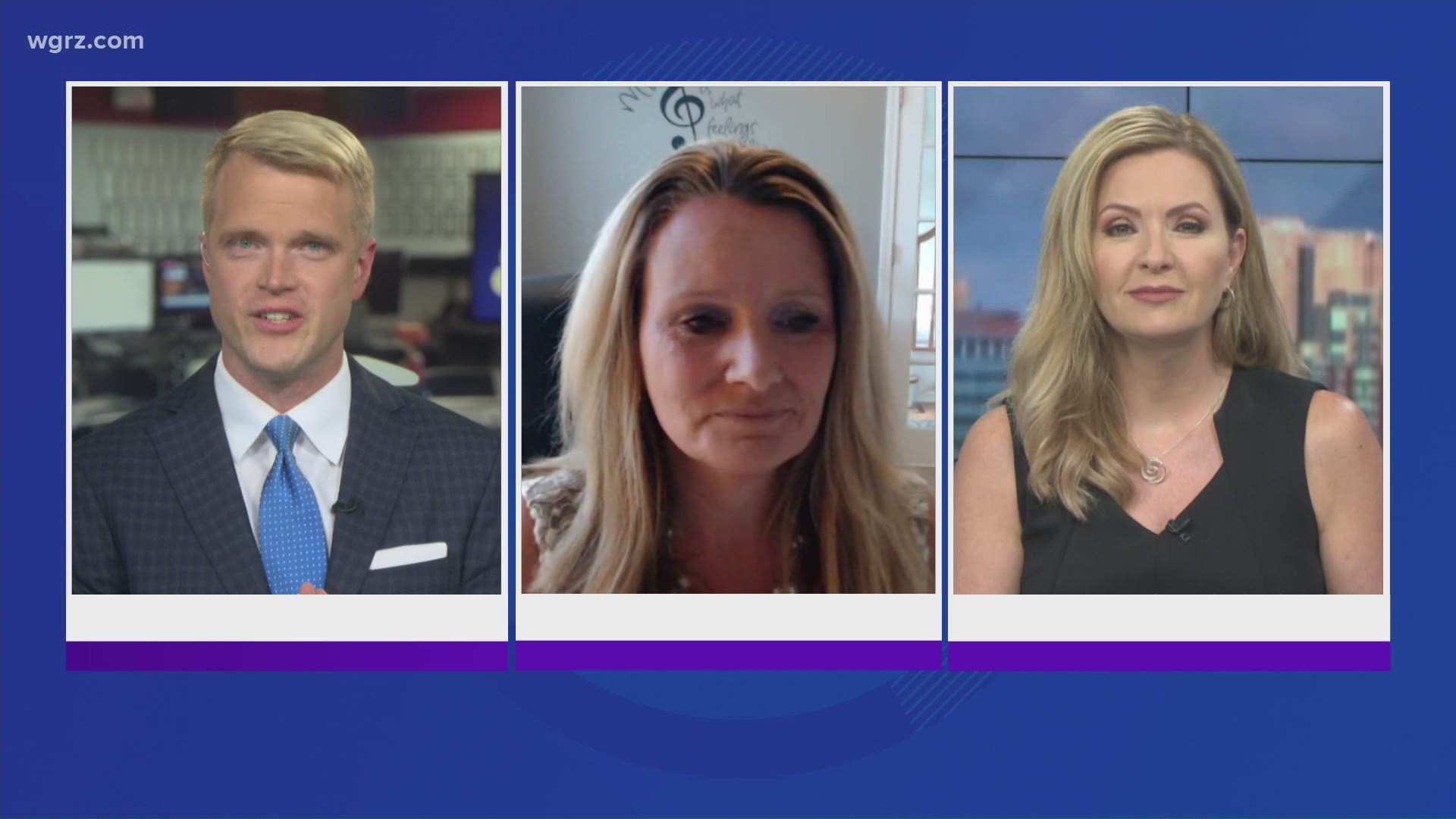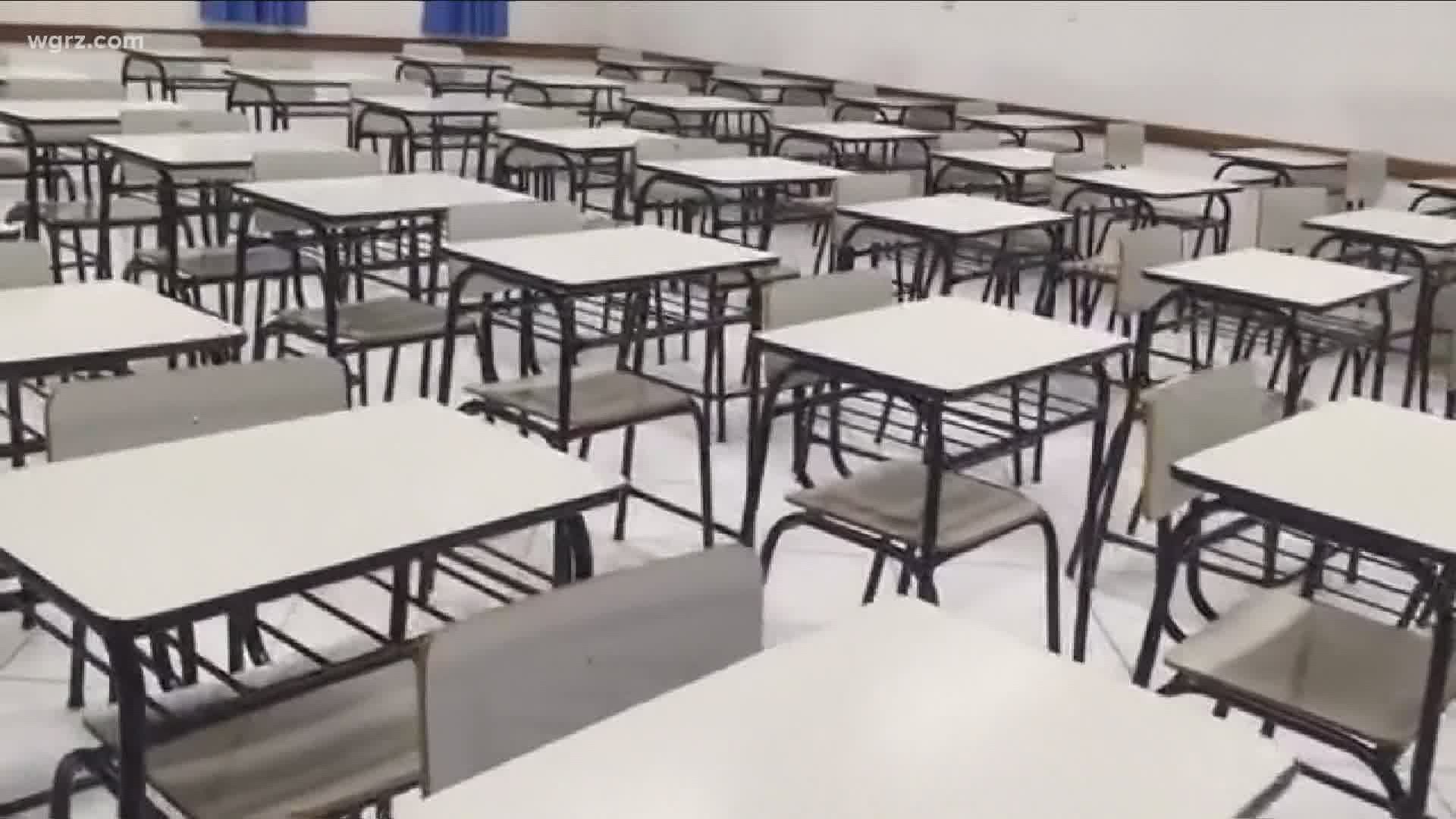BUFFALO, N.Y. — After weeks of preparation, the New York State Education Department has released guidance for the upcoming academic year.
The guidance can be viewed here.
The school reopening guidance is extensive -- it’s a document of 145 pages long.
State Ed encourages districts to work with members of their community to find out how best to deliver curriculum to students – whether that’s in person schooling, virtual or a mix of both.
For in person schooling, schools are recommended to stagger arrival and dismissal times. Face masks are required to be worn, but districts need to figure out when mask breaks can be taken. Schools need to figure out how to keep students socially distant -- if schools plan to expand their square footage there needs to be a code review. State Ed says tents can be used.
And, school buses need to be disinfected regularly. Students who are able, need to wear a mask and be socially distant.
The guidance says students with a mask cannot be denied transportation. And, schools need to come up with a visitation policy.
Schools will be required to do health checks. Parents and guardians need to be trained on what to look for. Schools also need to come up with plans on how to isolate students or staff if they become ill.
Schools are encouraged to open windows when possible and turn desks in the same direction to reduce the risk of transmission. Playgrounds can be used as long as safety procedures are in place.
There are also recommendations for how many masks schools should keep on hand.
Catherine Collins, a member of the New York State Board of Regents spoke to 2 On Your Side Thursday, giving some of the highlights of the state’s guidance for reopening schools.
Collins, who is from Buffalo, has been part of the process in crafting the guidance and getting opinions from educators across the state.
“The big takeaway is how we incorporated people throughout the state,” Collins said in a Zoom interview.
Collins says the guidance will give districts a lot of control over how they plan to conduct classes this coming school year – whether it be in-person, virtual or a hybrid model.
“It will be up to the districts to decide on how they want to offer the curriculum,” she said.
Collins says she has concerns about kids being left behind this academic year due to the pandemic and challenges in offering virtual classrooms.
Districts need to come up with reopening plans by the end of the month and submit them to the state. Gov. Andrew Cuomo has said that a decision on schools will be made in early August based on Covid data.
Here is a summary of the state's guidelines from their report. You can read the full, detailed report here.
Health and Safety
Focused on preventive actions, schools and districts will be required to perform health checks and screenings, per DOH guidance, and recognize signs and symptoms of illness in students and staff; develop plans to maximize social distancing; develop plans to manage and isolate ill persons until they can be sent home; instruct students and staff in proper hand and respiratory hygiene; require wearing appropriate face coverings; and develop cleaning and disinfection procedures for the school in accordance with CDC and DOH guidance.
Facilities
Schools and school districts should promote social distancing while maintaining existing safety requirements designed to protect students. To accomplish this, schools may expand their physical footprint or change the way they utilize space. Schools should also continue to meet or exceed ventilation requirements and may wish to consult with design professionals to increase ventilation and filtration.
Schools must continue to conduct mandatory fire and lockdown drills according to the existing stat¬utory schedule. School leaders will need to plan for these drills to be conducted in a manner that maintains social distancing at exits and gathering points outside the building, while still preparing students to respond in emergencies.
Nutrition
Schools and school districts should include food service directors in reopening plan discussions so they are able to meet their requirements to provide all enrolled students with access to school meals each school day whether school is in-person or remote; address all applicable health and safety guidelines; ensure compliance with Child Nutrition Program requirements; and communicate with families through multiple means, in the languages spoken by those families.
Transportation
The school bus is an extension of the classroom and services should be provided to all students with consistency and equity. Each district will be required to: perform regular school bus disinfec¬tion measures; train students and school bus staff regarding social distancing on the bus, at stops, and at unloading times; and train students and staff regarding the wearing of masks. Both students and drivers will wear masks and social distance on the bus. Districts will continue to provide trans¬portation to homeless students, students in foster care, those who attend religious, independent or charter schools – and those with disabilities – just as they always have.
Social-Emotional Well-Being
As school and district personnel adapt to environments that result in substantially less time spent interacting in-person, ensuring intentional and meaningful inclusion of social emotional learning (SEL) across all aspects of operating strategies is critical to support the well-being and success of students, staff, and families. Along with physical health and well-being, schools and districts must also prioritize social emotional well-being – not at the expense of academics, but in order to create the mental, social, and emotional space for academic learning to occur.
School Schedules
Schools must create a comprehensive plan for a schedule that includes in-person instruction, re¬mote instruction or a hybrid of both in-person and remote. All plans should be clearly communicated, with as much advance notice as practicable, to students, families and staff. To adhere to state and local health and safety guidelines and ensure social distancing practices, schools may consider various reopening plans and schedules that stagger or alternate their stu¬dents’ return to campus. Schools should collaborate with district stakeholders when considering alternate schedules.
Budget and Fiscal
All schools and school districts must continue to meet existing state aid reporting requirements. Additionally, the content of data submissions, such as attendance data, will remain consistent with past practice, except where modified by law, regulation or executive order.
Attendance and Chronic Absenteeism
Schools must develop a mechanism to collect and report daily teacher student engagement or at¬tendance. While this requirement is straightforward in an in-person setting, a procedure should be developed to make daily contact with students in remote or hybrid settings. Schools may consider for instance, assigning the homeroom teacher or advisory teacher to be the point of contact to touch base with a specific group of students daily. Attendance data must be reported in the student infor¬mation reporting system or SIRS. School policies and procedures must focus on the academic con-sequences of lost instructional time and address absences before students fall behind in school. It is critical for schools to use a variety of creative methods to reach out to students and their families who have not engaged in distance learning.
Technology and Connectivity
Adequate access to a computing device and high-speed broadband is essential for educational eq¬uity. Schools and districts must determine the level of access all students and teachers have in their places of residence; to the extent practicable, address the need to provide devices and internet access to students and teachers who currently do not have sufficient access; and provide multiple ways for students to participate in learning and demonstrate their mastery of the learning standards in remote and hybrid instructional models.
Schools and districts should provide instruction on using technology and IT support for students, teachers and families and provide professional development for teachers and leaders on designing effective online/remote learning experiences.
Teaching and Learning
Mandatory teaching and learning requirements include providing clear opportunities for equitable instruction for all students; ensuring continuity of learning regardless of the instructional model used; providing standards-based instruction; ensuring substantive daily interaction between teach¬ers and students; and clearly communicating information about instructional plans with parents and guardians.
To allow for schools and districts to adapt to complications caused by the pandemic, certain flexi¬bilities will be authorized, including: flexible student/staff ratio in prekindergarten; extended time for prekindergarten and kindergarten screening to be completed; a waiver allowing districts to convert UPK seats from full-day to half-day (not applicable to Statewide Universal Full Day Pre-K pro¬grams); flexibility with the 180 minutes per week Unit of Study requirement; flexibility in the delivery of physical education; allowance for a blend of hands-on and virtual science laboratory experienc-es; and when appropriate, districts and charters may utilize remote or virtual work-based learning experiences for CTE and CDOS programs.
Special Education
Schools and school districts are required to provide: a Free Appropriate Public Education consis¬tent with the need to protect the health and safety of students with disabilities and those providing special education and services; meaningful parental engagement regarding the provision of ser¬vices to their child; collaboration between the Committee on Preschool Special Education/Commit¬tee on Special Education (CPSE/CSE) and program providers representing the variety of settings where students are served; access to the necessary instructional and technological supports to meet the unique needs of students; and documentation of programs, services and communications with parents.
Schools and school districts should consider in-person services a priority for high-needs students and preschool students with disabilities whenever possible and consider contingency plans devel¬oped by the CPSE/CSE to address remote learning needs in the event of intermittent or extended school closures.
Bilingual Education and World Languages
Reopening plans must address the learning loss experienced by many English language learners (ELLs), in both their English language development and their mastery of content area knowledge. The Department has identified the following requirements and considerations that will allow schools to provide ELL services that address the impact of last year’s school closures and prepare them for potential challenges in the coming year. Schools and districts must:
- provide all communications to parents/guardians of ELLs in their preferred language and mode of communication to ensure that they have equitable access to critical information about their children’s education;
- ensure that all ELLs receive appropriate instruction that supports their college, career, and civic readiness, by providing them the required instructional Units of Study in their English as a New Language or Bilingual Education program based on their most recently measured English language proficiency level;
- conduct ELL identification for all students who enrolled during COVID-related school closures in 2019-20, during the summer of 2020, and during the first 20 days of the 2020-21 school year within 30 days of the start of the school year; and
- recognizing that all teachers are teachers of ELLs, provide professional learning opportunities related to the instruction and support of ELLs to all educators, as required by Part 154 of the Commissioner’s regulations.
Staffing and Human Resources
As schools and school districts create their plans for the 2020-21 school year, they must ensure that all teachers, school and district leaders and pupil personnel service professionals hold a valid and appro¬priate certificate for their assignment; can continue to utilize incidental teaching when determining how to staff their classrooms; can employ substitute teachers to address staffing needs for the allowable amount of days given their qualifications and teaching assignment; should work with educator prepara¬tion programs to identify appropriate ways in which student teachers can support classroom instruction; and should consider whether their currently approved APPR plans may need to be revised in order to be consistent with their plans for re-opening under an in-person, remote or hybrid instructional model.



